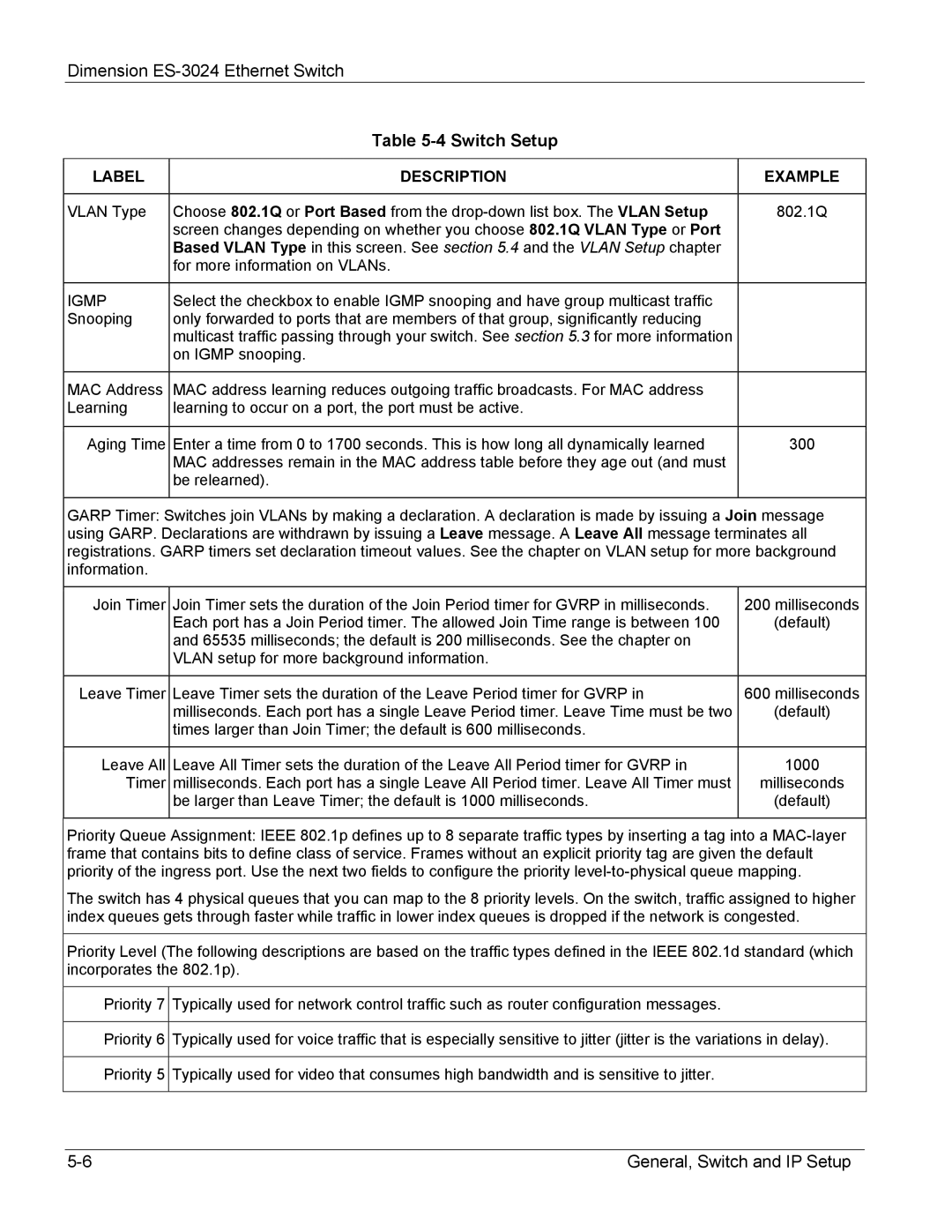
Dimension
Table 5-4 Switch Setup
LABEL | DESCRIPTION | EXAMPLE |
|
|
|
VLAN Type | Choose 802.1Q or Port Based from the | 802.1Q |
| screen changes depending on whether you choose 802.1Q VLAN Type or Port |
|
| Based VLAN Type in this screen. See section 5.4 and the VLAN Setup chapter |
|
| for more information on VLANs. |
|
|
|
|
IGMP | Select the checkbox to enable IGMP snooping and have group multicast traffic |
|
Snooping | only forwarded to ports that are members of that group, significantly reducing |
|
| multicast traffic passing through your switch. See section 5.3 for more information |
|
| on IGMP snooping. |
|
|
|
|
MAC Address | MAC address learning reduces outgoing traffic broadcasts. For MAC address |
|
Learning | learning to occur on a port, the port must be active. |
|
|
|
|
Aging Time | Enter a time from 0 to 1700 seconds. This is how long all dynamically learned | 300 |
| MAC addresses remain in the MAC address table before they age out (and must |
|
| be relearned). |
|
|
|
|
GARP Timer: Switches join VLANs by making a declaration. A declaration is made by issuing a Join message using GARP. Declarations are withdrawn by issuing a Leave message. A Leave All message terminates all registrations. GARP timers set declaration timeout values. See the chapter on VLAN setup for more background information.
Join Timer | Join Timer sets the duration of the Join Period timer for GVRP in milliseconds. | 200 milliseconds |
| Each port has a Join Period timer. The allowed Join Time range is between 100 | (default) |
| and 65535 milliseconds; the default is 200 milliseconds. See the chapter on |
|
| VLAN setup for more background information. |
|
|
|
|
Leave Timer | Leave Timer sets the duration of the Leave Period timer for GVRP in | 600 milliseconds |
| milliseconds. Each port has a single Leave Period timer. Leave Time must be two | (default) |
| times larger than Join Timer; the default is 600 milliseconds. |
|
|
|
|
Leave All | Leave All Timer sets the duration of the Leave All Period timer for GVRP in | 1000 |
Timer | milliseconds. Each port has a single Leave All Period timer. Leave All Timer must | milliseconds |
| be larger than Leave Timer; the default is 1000 milliseconds. | (default) |
|
|
|
Priority Queue Assignment: IEEE 802.1p defines up to 8 separate traffic types by inserting a tag into a
The switch has 4 physical queues that you can map to the 8 priority levels. On the switch, traffic assigned to higher index queues gets through faster while traffic in lower index queues is dropped if the network is congested.
Priority Level (The following descriptions are based on the traffic types defined in the IEEE 802.1d standard (which incorporates the 802.1p).
Priority 7 Typically used for network control traffic such as router configuration messages.
Priority 6 Typically used for voice traffic that is especially sensitive to jitter (jitter is the variations in delay).
Priority 5 Typically used for video that consumes high bandwidth and is sensitive to jitter.
General, Switch and IP Setup |
